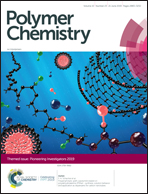Spatial control of the topography of photo-sensitive block copolymer thin films†
Abstract
We report the preparation of a block copolymer where the glass transition (Tg) of one block can be dramatically increased after undergoing a photoreaction. This involved introducing photo-sensitive nitrobenzyl esters into the pendant groups of one block, where photoreaction yields carboxylic acids that have a significantly higher Tg, due to hydrogen bonding. For a thin film geometry, the change in thermal properties allowed restructuring into a so-called island or hole topography to be restricted to nonirradiated areas. While mass transport was inhibited in the irradiated regions, periodic buckling that was aligned to the boundaries of the photopatterned regions could be induced, due to compressive forces during thermal annealing. We demonstrate that this process of selective UV irradiation and annealing can generate a topographically patterned surface and this mechanism should be applicable to any block copolymers where there is a difference in photoreactivity of the blocks.

- This article is part of the themed collection: Pioneering Investigators


 Please wait while we load your content...
Please wait while we load your content...